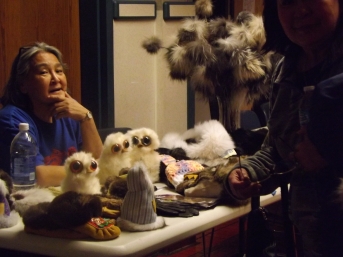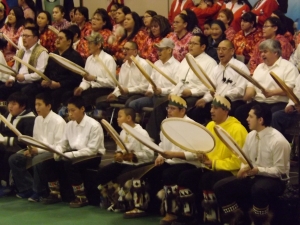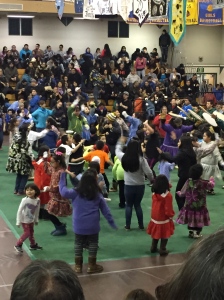Far from the lush forest where I grew up, Point Barrow in dead winter is a tundra wasteland – a vast, empty climate that rejects you. The air is too cold for exposed skin, the wind is worse, the sun won’t rise and when it does the light is weak, and if the weather doesn’t drive you indoors, than the threat of polar bears will. I have never felt so disconnected from the outside world than I do here; I have never felt so threatened by it before. Walking down the beach, the first time restlessness was enough to drive us out of the house in three weeks, Rachel and I had to don our full winter gear and stop ever once and a while to look over our shoulder for predators.
In contrast to this aggressive landscape are the people. The Inupiat people are warm and welcoming, loud and bright, and blooming in their traditional culture. In contrast to my fear of this world is the Inupiat’s deep connection with it.

Bowhead whale http://www.thecanadianencyclopedia.ca
Inupiat, or Inupiaq, translates into the “real people.” This Inuit tribe has inhabited Barrow for as long as 4,000 years, having crossed the Bering Land Bridge into Alaska. Ross once asked, “Can you think of any other culture that has such a dependent connection with one animal?” The answer is probably no. After surviving millenia in such a harsh environment, the Inupiat have a deep connection with the landscape as well as the creatures that sustain the population, such as seal, caribou, and above all, the bowhead whales.
Subsistence Hunting:
Though the native name for Barrow is Ukpeagvik meaning “the place where we hunt snowy owls”, the hunting of the whales persists as a central aspect of the Inupiat culture. The sustenance that whales provide to the community is immense as one whale can weigh up to 60 tons. Because of the whales’ monumental size, hunters work in teams headed under a whaling captain.
Maktak is the skin and blubber of the whale, and common food for the community. Once a whale is caught it does not belong to the hunters but instead to the whole community. Every single person is entitled to a share of the whale, including even those native to Barrow who have moved away. The meat is rich in vitamin A and C, which is the significant source of necessary nutrients to a community that has limited access to fruits and vegetables.
The early Inupiats would use harpoons and umiaqs, canoes made from whalebones and ugruk (bearded seal) skin, to hunt the whales. The seams of the boat were coated in seal oil to waterproof them. Though the skins of the boats, made from up to seven ugruks, have to be replaced every three years, the bowhead whale is sensitive to the metallic sounds of an aluminum boat so some Inuit peoples continue whaling with an umiaq today.
The umiaq is 24 ft long and can carry up to 30 passengers. Modern tribes will start the spring season by cutting trail to the ocean and towing the umiaqs behind a snowmobile; however, the ancient tribe could carry the boats over the ice because the umiaq is so light, only 150 lbs. Instead of the traditional harpoons, however, large guns are now used to kill the whales. Nelson, one of our bear guards, has told us whales can die instantly, though more often it happens over the course of three hours.

Bearded seal http://www.telegrapk.co.uk
Though the whale meat harvested in early spring can last much of the year, the hunting season comprises only a short time. The Inuit hunting calendar is marked by various seasons, such as it is in the Northeast, but instead of deer or duck, the Inupiat are hunting seal and caribou. The Inupiat tribe used to move with the game as nomads for most of the year hunting whale in the early spring, seal in the late spring, caribou in the summer and fish in the fall.
Modernization:
In 1826 Europeans came to the shores of the Alaskan north in search of a lost expedition group and renamed the area Barrow. Over time the Europeans brought commercial whaling ships, guns, trade, and disease, such as influenza, to Ukpeagvik. From that point onward the Inupiat people experienced rapid change. The European missionaries arrived in the late 1800’s and western medicine was introduced in 1920. Moreover, the North Slope is now home to the largest oil reserve in the Arctic, supplying jobs to the citizens of the nearby villages; dog sleds were replaced by snow machines, and seal oil lamps were replaced by electricity.
Celebrations:

Ellyn in front of the Kivgiq poster – photocred to some very nice lady who took pity on my alone-ness
Many of the traditions of the Inupiat people, however, are still celebrated today. Subsistence hunting is still a pivotal aspect of the Inupiat culture and the hunting calendar is still followed, though with more rules enforced by the US government—the only government that has anti-whaling laws but supports subsistence whaling. Two festivals are celebrated around the whaling season:
Annually, Nalukatak, the Spring Whaling Festival, takes place after the whaling season. One of the former purposes of this festival was to thank and appease the spirits of the whales that were killed in order to sustain the Inupiat community, and to ensure through spiritual means that the next whaling season will be successful.  “Naluk” means to toss up, and the festival is most famous for the blanket toss (the blanket is also made from seal skin like the umiaqs). People gather in the center of town to watch the whaling captains fly their flags and to throw their fellow denizens of Barrow into the air, traditionally whaling captains and their wives first. This is also the first time of the year in which whale meat is distributed. Whale meat can be in many forms: quaq is frozen raw whale meat, maktak is the skin and the blubber, and avarraq is the fluke (tail) cut into thin strips.
“Naluk” means to toss up, and the festival is most famous for the blanket toss (the blanket is also made from seal skin like the umiaqs). People gather in the center of town to watch the whaling captains fly their flags and to throw their fellow denizens of Barrow into the air, traditionally whaling captains and their wives first. This is also the first time of the year in which whale meat is distributed. Whale meat can be in many forms: quaq is frozen raw whale meat, maktak is the skin and the blubber, and avarraq is the fluke (tail) cut into thin strips.
 This year our team was lucky enough to witness another festival, Kivgiq.
This year our team was lucky enough to witness another festival, Kivgiq. This midwinter celebration, also called the messenger feast, comes after a strong whaling season, about every 2-3 years. People from all over the Arctic Circle come to attend what is mostly a festival of traditional dancing. For a whole week there are performances happening from 9 AM to midnight ranging from dancing to singing to praying; not to mention the craft fair where many residents display and sell beautifully hand-crafted artwork often using baleen or seal skin. (Rachel even bought earrings made from walrus whiskers)
This midwinter celebration, also called the messenger feast, comes after a strong whaling season, about every 2-3 years. People from all over the Arctic Circle come to attend what is mostly a festival of traditional dancing. For a whole week there are performances happening from 9 AM to midnight ranging from dancing to singing to praying; not to mention the craft fair where many residents display and sell beautifully hand-crafted artwork often using baleen or seal skin. (Rachel even bought earrings made from walrus whiskers)
The dances are lead by a line of men keeping time on drums made of the lungs or liver of a whale, and singing in Inuktitut, the common language. The dancers express their stories mostly with their hands, which are gloved for emphasis (and possibly other reasons that I could not find on the internet.) In every intermission between dance groups the drummers play a familiar song during which many members of the community go to the dance floor to partake in a dance that apparently everyone knows—the women all have one part and the men have another.
Elders sit in the front, and most of the floor seats are reserved for them. One woman who works at Lilliana’s Fresh Baked told us, if you are going to sit in front of an elder it is okay to be kneeling but you cannot block their view.
Often someone would be giving a speech at the stage about one thing or another, unheard over the loud sounds of community members coming and going between dances, but often an elder or whaling captain would be called out and congratulated. It seemed, too, that every person knew the oldest man in the crowd and paid their respects to him. Many elders were invited up to dance in front of the drummers and show their incredible and lasting spirit. We even saw one boy wearing a t-shirt that said “elder in training.”
Current issue with Climate change:
Within recent years climate change has become a growing concern for the Inupiat population. A warming trend in the Arctic affects the extent and thickness of the sea ice, which makes harvesting bowhead whales, seals, or caribou more difficult since the ice serves as the hunting ground. Additionally, warm winters are making travel over the ice more dangerous.
Furthermore, land fast ice is slower to form, making the coastline susceptible to erosion as it is now exposed to the winter currents for a longer period of time. A group representing the people of the Arctic, the Inuit Circumpolar Council, is very concerned about climate change and makes the case that the effects on the North Slope are a threat to the human rights of the Inuit people.
Traditional Recipes
Ahmiiniluk
Cut and clean tuttu (caribou) intestines and fry
Palaugaaq
Put Quagak (duck) or Nigliq(goose) in a pot of water and cover
Boil for ½ hour and then let simmer for several hours or until the meat is falling off the bones.
Add onions, rice, salt and pepper to taste and cook for another ½ hour
Stir in a little flour and stir until thickened
Barrow’s Finest Pickled Maktak
Boil maktak for thirty minutes with plenty of salt and pepper. Cut into bit sized pieces
Make brine (4 pints):
2c white vinegar 2tsp mustard seeds
1 ¾ c sugar 1tsp black pepper
4 bay leaves 1tsp allspice
5 cloves 1tsp pickling spice
Bring to a boil until the maktak begins to float (about 10 mins); let cool
Put maktak in jars with slices of lemon, onion, and orange
Pour brine over maktak and let it stand for one week in the refrigerator
Mamaaq
This is the white stuff at the base of baleen plates on a bowhead whale, often called Eskimo chewing gum. Cut the mamaaq off from the baleen plates. Chew! You may soak it in seal oil first.
Akutuq (Eskimo Ice Cream)
Every family will have their own version—Akutuq is a rich-tasting concoction that resembles frozen froth.
1quart caribou fat
2-4c of berries
Grind the caribou fat very fine. Bring to room temperature and add berries. Stir well and chill for about two hours.











Dear Ellyn: You may feel disconnected in Ukpeagvik, but your audience here in the boring real world is reading your informative blog with great interest! Just don’t forget the rifle when you and Rachel take beach walks. You could at least brain the polar bear before he has you for lunch. Thanks for the recipes! I hope Rachel is shopping at the craft fair for snowy owls and other treasures.
LikeLike
I really like Barrow, it’s like one big intentional community! Nice people.
LikeLike